
|
|
Font Size:
|
||||
|
|
|
|
||||
STATISTICAL BRIEF #193:
National Health Care Expenses in the U.S. Civilian Noninstitutionalized Population, 2005
Highlights
- Overall, the mean and median expenses of persons with expenses in 2005 (84.7 percent of the population) were $4,082 and $1,166, respectively.
- In 2005, hospital inpatient expenses and office-based/hospital outpatient ambulatory care services were each nearly one-third while prescribed medicines were about one-fifth of total expenses.
- Hospital inpatient expenses comprised the largest share of expenses for persons age 65 and over, while expenses for ambulatory care in office and hospital outpatient settings comprised the largest share for persons under age 65.
- In 2005, private insurance covered 41.6 percent of expenses, individuals and family members paid 18.8 percent out of pocket, Medicare paid 21.1 percent, and Medicaid paid 11.2 percent. While the proportions paid out of pocket were fairly similar across age groups, shares paid by public and private insurance sources varied greatly by age.
- Mean expenses for persons age 65 and over ($9,074) were nearly three times that for persons under 65 ($3,239). Uninsured persons under 65 had the lowest mean expenses while persons 65 and over with Medicare and supplemental public insurance had the highest mean expenses.
Introduction
This Statistical Brief presents estimates of health care expenses by type of service and distributions by payment sources for the U.S. civilian noninstitutionalized population in 2005. The estimates are derived from data collected in the Medical Expenditure Panel Survey Household Component (MEPS-HC) and Medical Provider Component (MEPS-MPC). Health care expenses, as reported in this brief, represent payments to hospitals, physicians, and other health care providers for services reported by respondents in the MEPS-HC. These payments include amounts paid by individuals, private insurance, Medicare, Medicaid, and other payment sources. All differences between estimates discussed in the text are statistically significant at the 0.05 level or better.
Findings
In 2005, there was an estimated total of $1.02 trillion paid for hospital inpatient and outpatient care, emergency room services, office-based medical provider services, dental services, home health care, prescription medicines, and/or other medical services and equipment for about 296.2 million persons in the U.S. civilian noninstitutionalized population (figure 1). Hospital inpatient expenses for both facility and separately billed physician services accounted for 30.9 percent of total expenses, and a similar share of expenses were attributable to combined ambulatory care provided in medical offices (22.1 percent) and hospital outpatient departments (9.4 percent). While prescribed medicines accounted for approximately one-fifth of health expenses (20.8 percent), other health service categories comprised relatively small percentages of the total, ranging from 2.1 percent for other medical services and equipment to 7.1 percent for dental services.
In 2005, 84.7 percent of the U.S. civilian noninstitutionalized population had some expenses for hospital inpatient and outpatient care, emergency room services, office-based medical provider services, dental services, home health care, prescription medicines, and/or other medical services and equipment (figure 2).1 The proportion of people with expenses varied widely by type of service, with large proportions having expenses for office-based medical provider visits (71.3 percent) and prescribed medicines (63.1 percent) and much smaller proportions having expenses for hospital inpatient services (7.5 percent) and home health care (2.2 percent).
For persons with an expense for any type of health care service, the mean total expenses per person in 2005 were $4,082 (figure 3). Among specific health care service categories, the mean expense per person with an expense ranged from highs of $14,240 for hospital inpatient services and $6,986 for home health care to lows of $579 for dental services and $361 for other medical services and equipment. Because a relatively small proportion of persons account for a large proportion of expenses, median expenses were substantially lower than the level of mean expenses (figure 4). The overall median total expense for persons with expenses was $1,166, and ranged across service categories from highs of $7,302 for hospital inpatient services and $2,316 for home health care to lows of $214 for dental services and $204 for other medical services and equipment.
The distribution of expenses by type of service varied substantially by age (figure 5). Hospital inpatient expenses comprised 37.2 percent of expenses for persons age 65 and over compared to 28.1 percent for adults age 18-64 and 26.7 percent for children under 18. Compared to adults, a substantially smaller share of total expenses for children under 18 were for prescribed medicines (14.1 versus nearly 22 percent for adults 18 and over). Conversely, a substantially larger share of children's expenses were for dental services (18.1 percent) than for adults age 18-64 (7.2 percent) or 65 and over (3.5 percent). Expenses for emergency room care comprised a fairly small share of total expenses in all age groups, but comprised the highest share for children (5.4 percent).
Health care expenses are paid by individuals and third-party payers, such as private insurance and public programs. In 2005, private insurance covered 41.6 percent of the total expenses; individuals and family members paid 18.8 percent out of pocket, Medicare paid 21.1 percent, and Medicaid paid 11.2 percent (figure 6). While the proportions paid out of pocket were fairly similar across age groups, shares paid by public and private sources varied considerably. For example, private insurance paid for over half of expenses for persons under 65 years of age, but only 17.6 percent of expenses for persons age 65 and over. Conversely, Medicare paid for over half of expenses (53.4 percent) for persons age 65 and over versus only a very small proportion for younger persons. Moreover, Medicaid paid about one-quarter of expenses for children under 18 (24.1 percent), which was nearly twice the proportion for adults age 18-64 (12.5 percent) and nearly 5 times that for persons age 65 and over (5.0 percent).
As shown in figure 7, average annual health care expenses varied substantially by age and type of health insurance coverage. People under 65 years of age with an expense had a mean total expense of $3,239 and a median total expense of $911, while those 65 years and older had a mean total expense of $9,074 and a median total expense of $4,085. Mean expenses were lowest for people under age 65 who were uninsured ($1,856) and were roughly half the level of their privately and publicly insured counterparts. In contrast, persons age 65 and older on Medicare with supplemental other public insurance had the highest mean expenses ($11,521).
Data Source
The estimates in this Statistical Brief are based upon data from the 2005 Full-Year Consolidated Data File, HC-097.
Definitions
Expenditures
Expenditures included the total direct payments from all sources to hospitals, physicians, other health care providers (including dental care), and pharmacies for services reported by respondents in the MEPS-HC. Expenditures for hospital-based services include those for both facility and separately billed physician services.
Sources of payment
- Out-of-pocket: This category includes expenses paid by the user or other family member.
- Private insurance: This category includes payments made by insurance plans covering hospital and medical care (excluding payments from Medicare, Medicaid, and other public sources). Payments from Medigap plans or TRICARE (Armed Forces-related coverage) are included. Payments from plans that provide coverage for a single service only, such as dental or vision coverage, are not included.
- Medicare: Medicare is a federally financed health insurance plan for the elderly, persons receiving Social Security disability payments, and most persons with end-stage renal disease. Medicare Part A, which provides hospital insurance, is automatically given to those who are eligible for Social Security. Medicare Part B provides supplementary medical insurance that pays for medical expenses and can be purchased for a monthly premium.
- Medicaid: Medicaid is a means-tested government program jointly financed by federal and state funds that provides health care to those who are eligible. Program eligibility criteria vary significantly by state, but the program is designed to provide health coverage to families and individuals who are unable to afford necessary medical care.
- Other sources: This category includes payments from the Department of Veterans Affairs (except TRICARE); other federal sources (Indian Health Service, military treatment facilities, and other care provided by the Federal Government); various state and local sources (community and neighborhood clinics, state and local health departments, and state programs other than Medicaid); Workers' Compensation; various unclassified sources (e.g., automobile, homeowner's, or other liability insurance, and other miscellaneous or unknown sources); Medicaid payments reported for persons who were not reported as enrolled in the Medicaid program at any time during the year; and private insurance payments reported for persons without any reported private health insurance coverage during the year.
Individuals under age 65 were classified in the following three insurance categories, based on household responses to health insurance status questions:
- Any private health insurance: Individuals who, at any time during the year, had insurance that provides coverage for hospital and physician care (other than Medicare, Medicaid, or other public hospital/physician coverage) were classified as having private insurance. Coverage by TRICARE (Armed Forces-related coverage) was also included as private health insurance. Insurance that provides coverage for a single service only, such as dental or vision coverage, was not included.
- Public coverage only: Individuals were considered to have public coverage only if they met both of the following criteria: 1) they were not covered by private insurance at any time during the year, 2) they were covered by any of the following public programs at any point during the year: Medicare, Medicaid, or other public hospital/physician coverage.
- Uninsured: The uninsured were defined as people not covered by private hospital/physician insurance, Medicare, TRICARE, Medicaid, or other public hospital/physician programs at any time during the entire year or period of eligibility for the survey.
- Medicare and private insurance: This category includes persons classified as Medicare beneficiaries and covered by Medicare and a supplementary private policy.
- Medicare and other public insurance: This category includes persons classified as Medicare beneficiaries who met both of the following criteria: 1) They were not covered by private insurance at any point during the year, 2) They were covered by one of the following public programs at any point during the year: Medicaid, other public hospital/physician coverage.
- Medicare only: This category includes persons classified as Medicare beneficiaries but not classified as Medicare and private insurance or as Medicare and other public insurance. This group includes persons who were enrolled in Medicare HMOs and persons who had Medicare fee-for-service coverage only.
About MEPS-HC
MEPS-HC is a nationally representative longitudinal survey that collects detailed information on health care utilization and expenditures, health insurance, and health status, as well as a wide variety of social, demographic, and economic characteristics for the civilian noninstitutionalized population. It is cosponsored by the Agency for Healthcare Research and Quality and the National Center for Health Statistics.
For more information about MEPS, call the MEPS information coordinator at AHRQ (301-427-1406) or visit the MEPS Web site at http://www.meps.ahrq.gov/.
References
Cohen, J. Design and Methods of the Medical Expenditure Panel Survey Household Component. MEPS Methodology Report No. 1. AHCPR Pub. No. 97-0026. Rockville, MD.: Agency for Healthcare Policy and Research, 1997. http://www.meps.ahrq.gov/mepsweb/data_files/publications/mr1/mr1.shtml
Cohen, S. Sample Design of the 1996 Medical Expenditure Panel Survey Household Component. MEPS Methodology Report No. 2. AHCPR Pub. No. 97-0027. Rockville, MD.: Agency for Health Care Policy and Research, 1997. http://www.meps.ahrq.gov/mepsweb/data_files/publications/mr2/mr2.shtml
Cohen, S. Design Strategies and Innovations in the Medical Expenditure Panel Survey. Medical Care, July 2003: 41(7) Supplement: III-5-III-12.
Suggested Citation
Kashihara, D., Machlin, S. and Carper, K. National Health Care Expenses in the U.S. Civilian Noninstitutionalized Population, 2005. Statistical Brief #193. December 2007. Agency for Healthcare Research and Quality, Rockville, MD. http://www.meps.ahrq.gov/mepsweb/data_files/publications/st193/stat193.shtml
AHRQ welcomes questions and comments from readers of this publication who are interested in obtaining more information about access, cost, use, financing, and quality of health care in the United States. We also invite you to tell us how you are using this Statistical Brief and other MEPS data and tools and to share suggestions on how MEPS products might be enhanced to further meet your needs. Please e-mail us at mepspd@ahrq.gov or send a letter to the address below:
Steven B. Cohen, PhD, Director
Center for Financing, Access, and Cost Trends
Agency for Healthcare Research and Quality
540 Gaither Road
Rockville, MD 20850
Footnotes
1 Of the 15.3 percent of the population with no health care expenses, a very small proportion actually received health services for which no direct payments were made.
 |
||||||||||||||||||||||||||||||
Note: Percents do not add to exactly 100.0 due to rounding. | ||||||||||||||||||||||||||||||
|
|
||||||||||||||||||||||||||||||
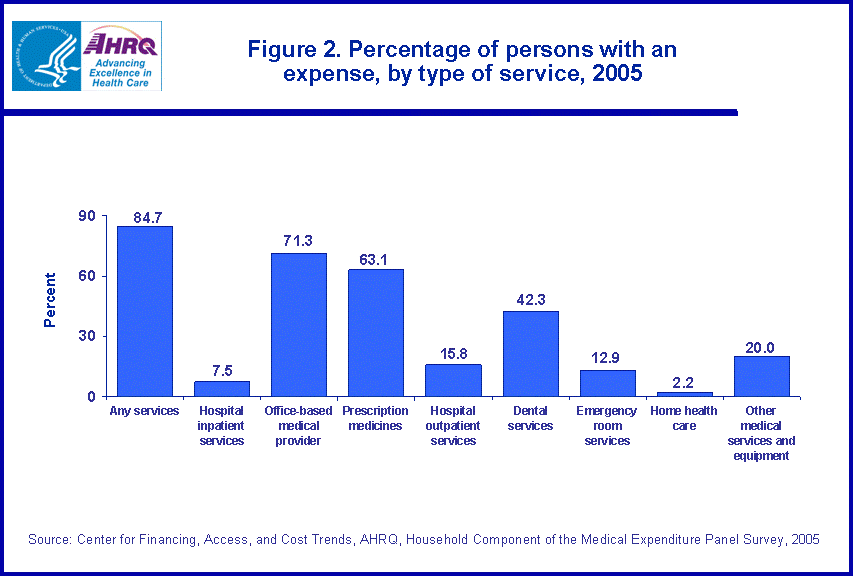 |
||||||||||||||||||||||||||||||
Source: Center for Financing, Access, and Cost Trends, AHRQ, Household Component of the Medical Expenditure Panel Survey, 2005 | ||||||||||||||||||||||||||||||
|
|
||||||||||||||||||||||||||||||
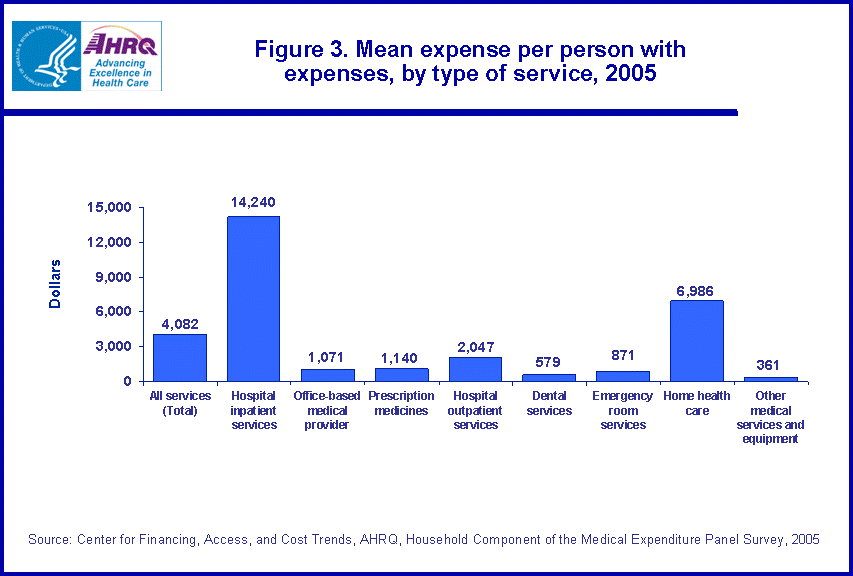 |
||||||||||||||||||||||||||||||
Source: Center for Financing, Access, and Cost Trends, AHRQ, Household Component of the Medical Expenditure Panel Survey, 2005 | ||||||||||||||||||||||||||||||
|
|
||||||||||||||||||||||||||||||
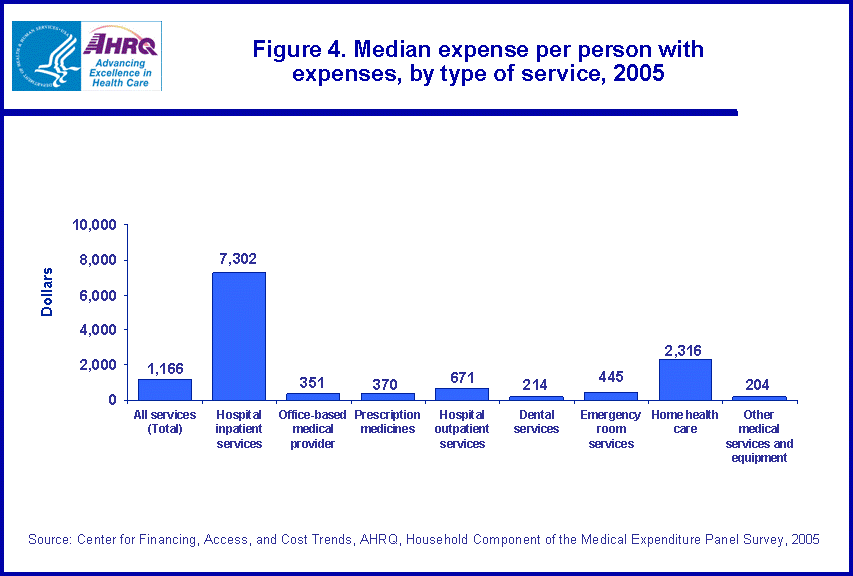 |
||||||||||||||||||||||||||||||
Source: Center for Financing, Access, and Cost Trends, AHRQ, Household Component of the Medical Expenditure Panel Survey, 2005 | ||||||||||||||||||||||||||||||
|
|
||||||||||||||||||||||||||||||
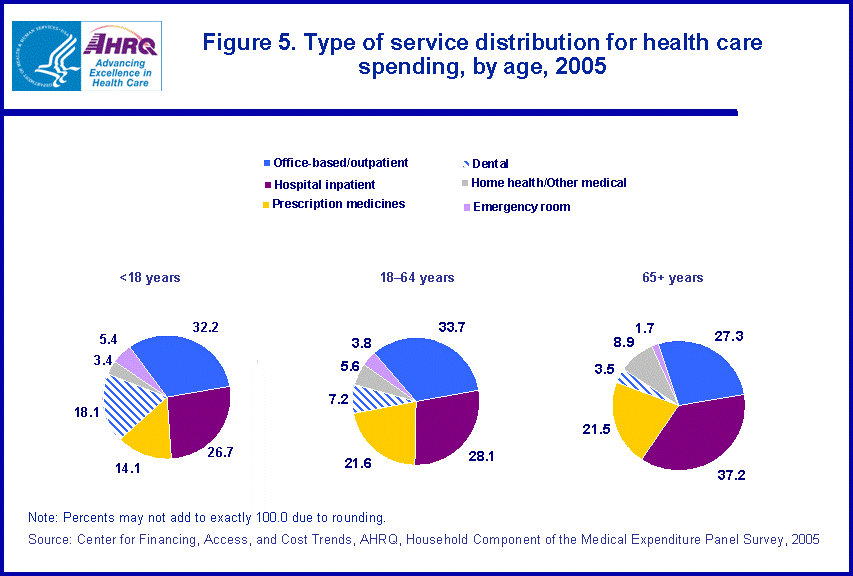 |
||||||||||||||||||||||||||||||
Note: Percents may not add to exactly 100.0 due to rounding. | ||||||||||||||||||||||||||||||
|
|
||||||||||||||||||||||||||||||
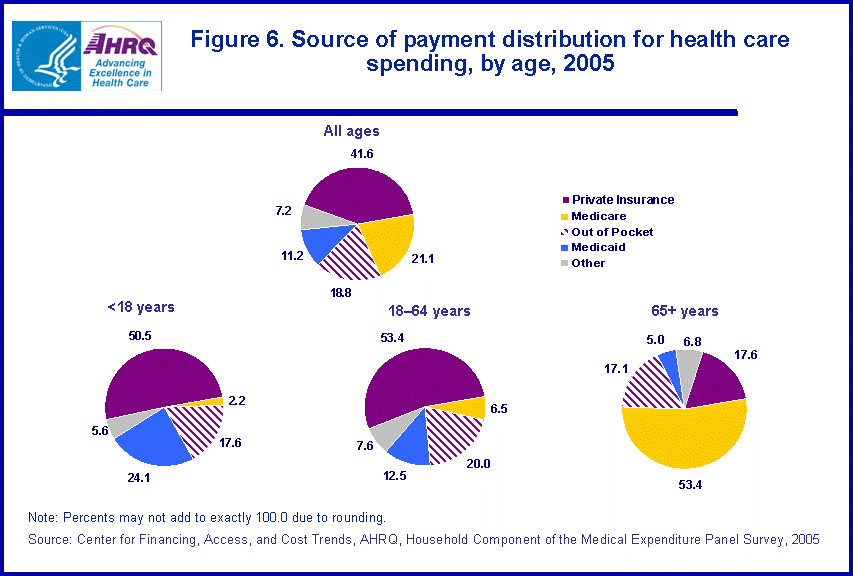 |
||||||||||||||||||||||||||||||
Note: Percents may not add to exactly 100.0 due to rounding. | ||||||||||||||||||||||||||||||
|
|
||||||||||||||||||||||||||||||
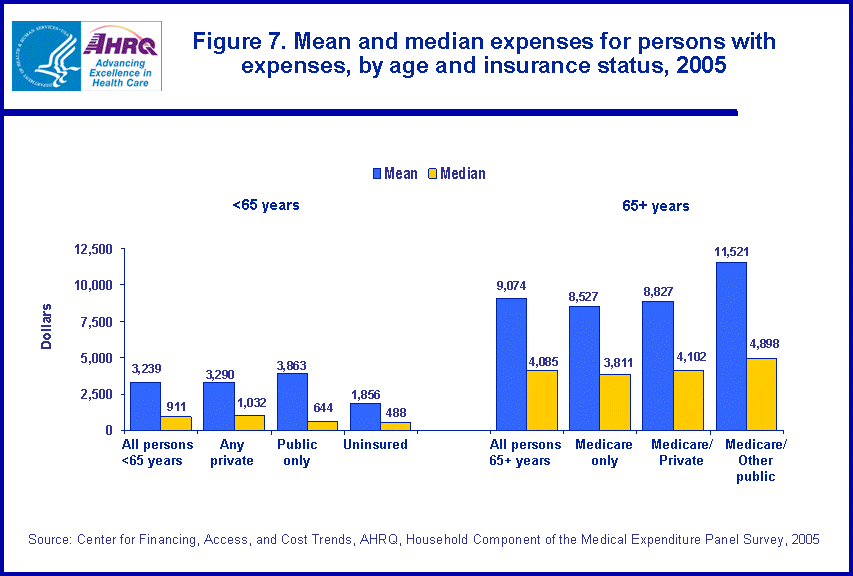 |
||||||||||||||||||||||||||||||
Source: Center for Financing, Access, and Cost Trends, AHRQ, Household Component of the Medical Expenditure Panel Survey, 2005
Source: Center for Financing, Access, and Cost Trends, AHRQ, Household Component of the Medical Expenditure Panel Survey, 2005 |
||||||||||||||||||||||||||||||
|
|


